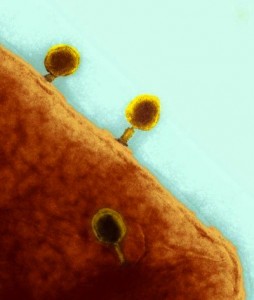T4 bacteriophages on E. coli. Transmission electron micrograph of two T4 bacteriophage virus particles on the surface of an Escherichia coli (E. coli) bacterium, and one inside the bacterium. A bacteriophage is a virus that infects bacteria. It consists of an icosahedral (20-sided) head (lower right), which contains the genetic material, a tail (cylinder) and tail fibres (leg-like), which fix it to a specific receptor site. Once attached to a bacterium, the bacteriophage injects its DNA and the bacterium’s cellular mechanisms are used to produce more bacteriophages. The T4 bacteriophage only infects E. coli bacteria.
